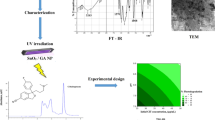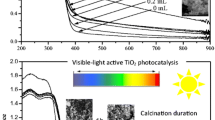Abstract
Photocatalytic degradations of tricyclic antidepressive amitriptyline (AMI) in aqueous solutions under UV irradiation were performed using TiO2 and TiO2/WO3 coatings, as photocatalysts. Coatings were formed on a pure titanium substrate using plasma electrolytic oxidation (PEO). The effects of chosen synthesis parameters on structural properties of prepared coatings have been investigated using micro-Raman spectroscopy and non-contact atomic force microscopy. Raman scattering measurements showed that coatings contain different amounts of crystalline anatase TiO2 and monoclinic WO3−x phases, as well as amorphous and/or disordered phases of both oxides. Also, results indicated that coatings’ surface become more disordered and inhomogeneous with increasing duration of the PEO. The coating T/W(45 s) prepared during 45 s of PEO has shown the highest efficiency in the UV-driven removal of AMI. T/W(45 s) showed slightly decrease in photodegradation efficiency after four successive runs. The results showed that the degradation of AMI led to the formation of ionic by-products (nitrite, nitrate, ammonium ion, acetate, and formate), whereas degree of mineralization was the highest (38.8%) using coating T/W(45 s) after 120 min of irradiation. Also, there was no significant toxicity observed after irradiation of AMI solutions using different coatings on four mammalian cell lines: rat hepatoma, mouse neuroblastoma, human colon adenocarcinoma, and human fetal lung.









Similar content being viewed by others
References
Sarkar S, Das R, Choi H, Bhattacharjee C (2014) Involvement of process parameters and various modes of application of TiO2 nanoparticles in heterogeneous photocatalysis of pharmaceutical wastes – a short review. RSC Adv 4:57250–57266. https://doi.org/10.1039/c4ra09582k
Dong H, Zeng G, Tang L, Fan C, Zhang C, He X, He Y (2015) An overview on limitations of TiO2-based particles for photocatalytic degradation of organic pollutants and the corresponding counter measures. Water Res 79:128–146. https://doi.org/10.1016/j.watres.2015.04.038
Li Puma G, Bono A, Krishnaiah D, Collin JG (2008) Preparation of titanium dioxide photocatalyst loaded onto activated carbon support using chemical vapor deposition: a review paper. J Hazard Mater 157:209–219. https://doi.org/10.1016/j.jhazmat.2008.01.040
Finčur NL, Krstić JB, Šibul FS, Šojić DV, Despotović VN, Banić ND, Agbaba JR, Abramović BF (2017) Removal of alprazolam from aqueous solutions by heterogeneous photocatalysis: influencing factors, intermediates, and products. Chem Eng J 307:1105–1115. https://doi.org/10.1016/j.cej.2016.09.008
Ay SB, Perkgoz NK (2015) Nanotechnological advances in catalytic thin films for green large-area surfaces. J Nanomater 2015:257547. https://doi.org/10.1155/2015/257547
Avisar D, Horovitz I, Lozzi L, Ruggieri F, Baker M, Abel ML, Mamane H (2013) Impact of water quality on removal of carbamazepine in natural waters by N-doped TiO2 photo-catalytic thin film surfaces. J Hazard Mater 244–245:463–471. https://doi.org/10.1016/j.jhazmat.2012.09.058
Pronin IA, Kaneva NV, Bozhinova AS, Averin IA, Papazova KI, Dimitrov DTS, Moshnikov VA (2014) Photocatalytic oxidation of pharmaceuticals on thin nanostructured zinc oxide films. Kinet Catal 55:167–171. https://doi.org/10.1134/S0023158414020074
Topkaya E, Konyar M, Yatmaz HC, Öztürk K (2014) Pure ZnO and composite ZnO/TiO2 catalyst plates: a comparative study for the degradation of azo dye, pesticide and antibiotic in aqueous solutions. J Colloid Interface Sci 430:6–11. https://doi.org/10.1016/j.jcis.2014.05.022
Xu T, Zheng H, Zhang P, Lin W, Sekiguchi Y (2015) Hydrothermal preparation of nanoporous TiO2 films with exposed 001 facets and superior photocatalytic activity. J Mater Chem A 3:19115–19122. https://doi.org/10.1039/c5ta02640g
Baena-Nogueras RM, González-Mazo E, Lara-Martín PA (2017) Degradation kinetics of pharmaceuticals and personal care products in surface waters: photolysis vs biodegradation. Sci Total Environ 590–591:643–654. https://doi.org/10.1016/j.scitotenv.2017.03.015
Byrne C, Subramanian G, Pillai SC (2018) Recent advances in photocatalysis for environmental applications. J Environ Chem Eng 6:3531–3555. https://doi.org/10.1016/j.jece.2017.07.080
Teixeira S, Gurke R, Eckert H, Kühn K, Fauler J, Cuniberti G (2016) Photocatalytic degradation of pharmaceuticals present in conventional treated wastewater by nanoparticle suspensions. J Environ Chem Eng 4:287–292. https://doi.org/10.1016/j.jece.2015.10.045
Fernández-Navarro JJ, Ruiz-Ángel MJ, García-Álvarez-Coque MC (2012) Reversed-phase liquid chromatography without organic solvent for determination of tricyclic antidepressants. J Sep Sci 35:1303–1309. https://doi.org/10.1002/jssc.201101106
Nabais JMV, Ledesma B, Laginhas C (2012) Removal of amitriptyline from aqueous media using activated carbons. Adsorpt Sci Technol 30:255–263. https://doi.org/10.1260/0263-6174.30.3.255
Kasprzyk-Hordern B, Dinsdale RM, Guwy AJ (2008) Multiresidue methods for the analysis of pharmaceuticals, personal care products and illicit drugs in surface water and wastewater by solid-phase extraction and ultra performance liquid chromatography–electrospray tandem mass spectrometry. Anal Bioanal Chem 391:1293–1308. https://doi.org/10.1007/s00216-008-1854-x
Lajeunesse A, Gagnon C, Sauvé S (2008) Determination of basic antidepressants and their N-desmethyl metabolites in raw sewage and wastewater using solid-phase extraction and liquid chromatography-tandem mass spectrometry. Anal Chem 80:5325–5333. https://doi.org/10.1021/ac800162q
Kasprzyk-Hordern B, Dinsdale RM, Guwy AJ (2008) The occurrence of pharmaceuticals, personal care products, endocrine disruptors and illicit drugs in surface water in South Wales, UK. Water Res 42:3498–3518. https://doi.org/10.1016/j.watres.2008.04.026
Togola A, Budzinski H (2008) Multi-residue analysis of pharmaceutical compounds in aqueous samples. J Chromatogr A 1177:150–158. https://doi.org/10.1016/j.chroma.2007.10.105
Finčur NL, Šćepanović MJ, Grujić-Brojčin MU, Abramović BF, Krstić JB, Kremenović A, Srećković T, Golubović A (2019) Adsorption and degradation of some psychiatric drugs by sol-gel synthesized titania-based photocatalysts: influence of tungsten and sodium content. J Sol Gel Sci Technol 90:510–524. https://doi.org/10.1007/s10971-019-04925-4
Stojadinović S, Radić N, Vasilić R, Petković M, Stefanov P, Zeković Lj, Grbić B (2012) Photocatalytic properties of TiO2/WO3 coatings formed by plasma electrolytic oxidation of titanium in 12-tungstosilicic acid. Appl Catal B-Environ 126:334–341. https://doi.org/10.1016/j.apcatb.2012.07.031
Abramović BF, Despotović VN, Šojić DV, Orčić DZ, Csanádi JJ, Četojević-Simin DD (2013) Photocatalytic degradation of the herbicide clomazone in natural water using TiO2: kinetics, mechanism, and toxicity of degradation products. Chemosphere 93:166–171. https://doi.org/10.1016/j.chemosphere.2013.05.024
Skehan P, Storeng R, Scudiero D, Monks A, McMahon J, Vistica D, Warren JT, Bokesch H, Kenney S, Boyd MR (1990) New colorimetric cytotoxicity assay for anticancer-drug screening. J Nat Cancer I 82:1170–1112. https://doi.org/10.1093/jnci/82.13.1107
Četojević-Simin DD, Velićanski AS, Cvetković DD, Markov SL, Mrđanović JŽ, Bogdanović VV, Šolajić SV (2012) Bioactivity of lemon balm kombucha. Food Bioprocess Technol 5:1756–1765. https://doi.org/10.1007/s11947-010-0458-6
Ohsaka T, Izumi F, Fujiki Y (1978) Raman spectrum of anatase, TiO2. J Raman Spectrosc 7:321–324. https://doi.org/10.1002/jrs.1250070606
Daniel MF, Desbat B, Lassegues JC, Gerand B, Figlarz M (1987) Infrared and Raman study of WO3 tungsten trioxides and WO3, xH2O tungsten trioxide hydrates. J Solid State Chem 67:235–247. https://doi.org/10.1016/0022-4596(87)90359-8
Gazzoli D, Valigi M, Dragone R, Marucci A, Mattei G (1997) Characterization of the zirconia-supported tungsten oxide system by laser Raman and diffuse reflectance spectroscopies. J Phys Chem B 101:11129–11135. https://doi.org/10.1021/jp971999o
Šćepanović MJ, Grujić-Brojčin M, Dohčević-Mitrović Z, Popović ZV (2007) Temperature dependence of the lowest frequency Eg Raman mode in laser-synthesized anatase TiO2 nanopowder. Appl Phys A Mater 86:365–371. https://doi.org/10.1007/s00339-006-3775-x
Schipporeit S, Mergel D (2018) Spectral decomposition of Raman spectra of mixed-phase TiO2 thin films on Si and silicate substrates. J Raman Spectrosc 49:1217–1229. https://doi.org/10.1002/jrs.5369
Hunge YM, Mahadik MA, Kumbhar SS, Mohite VS, Rajpure KY, Deshpande NG, Moholkar AV, Bhosale CH (2016) Visible light catalysis of methyl orange using nanostructured WO3 thin films. Ceram Int 42:789–798. https://doi.org/10.1016/j.ceramint.2015.08.178
Dohčević-Mitrović Z, Stojadinović S, Lozzi L, Aškrabić S, Rosić M, Tomić N, Paunović N, Lazović S, Nikolić MG, Santucci S (2016) WO3/TiO2 composite coatings: structural, optical and photocatalytic properties. Mater Res Bull 83:217–224. https://doi.org/10.1016/j.materresbull.2016.06.011
Chen S, Xiao Y, Xie W, Wang Y, Hu Z, Zhang W, Zhao H (2018) Facile strategy for synthesizing non-stoichiometric monoclinic structured tungsten trioxide (WO3−x) with plasma resonance absorption and enhanced photocatalytic activity. Nanomaterials 8:553. https://doi.org/10.3390/nano8070553
Kubo T, Nishikitani Y (1998) Deposition temperature dependence of optical gap and coloration efficiency spectrum in electrochromic tungsten oxide films. J Electrochem Soc 145:1729–1733. https://doi.org/10.1149/1.1838548
Bojinova A, Kaneva N, Papazova K, Eliyas A, Stoyanova-Eliyas E, Dimitrov D (2017) Green synthesis of UV and visible light active TiO2/WO3 powders and films for malachite green and ethylene photodegradation. Reac Kinet Mech Cat 120:821–832. https://doi.org/10.1007/s11144-016-1128-0
Bojinova A, Dushkin C (2011) Photodegradation of malachite green in water solutions by means of thin films of TiO2/WO3 under visible light. Reac Kinet Mech Cat 103:239–250. https://doi.org/10.1007/s11144-011-0295-2
Acknowledgements
Authors acknowledge financial support of the Ministry of Education, Science and Technological Development of the Republic of Serbia (Grant No. 451-03-68/2020-14/200125 and III45018). Also, the authors would like to thank Dr. Marko Radović for the AFM measurements of some investigated coatings.
Author information
Authors and Affiliations
Corresponding author
Ethics declarations
Conflict of interest
The authors declare that they have no conflict of interest.
Additional information
Publisher's Note
Springer Nature remains neutral with regard to jurisdictional claims in published maps and institutional affiliations.
Rights and permissions
About this article
Cite this article
Finčur, N.L., Grujić-Brojčin, M., Šćepanović, M.J. et al. UV-driven removal of tricyclic antidepressive drug amitriptyline using TiO2 and TiO2/WO3 coatings. Reac Kinet Mech Cat 132, 1193–1209 (2021). https://doi.org/10.1007/s11144-021-01936-7
Received:
Accepted:
Published:
Issue Date:
DOI: https://doi.org/10.1007/s11144-021-01936-7




